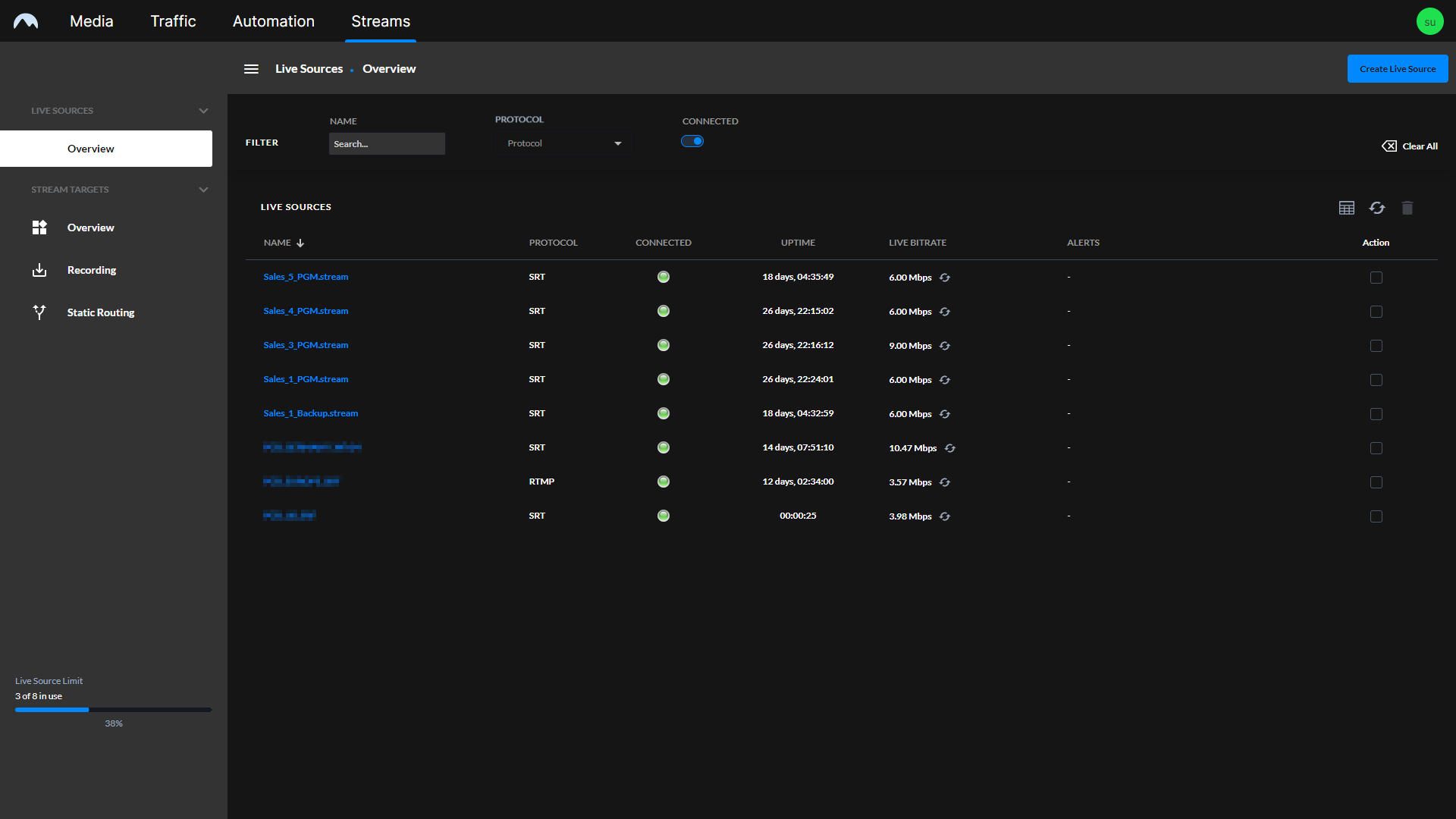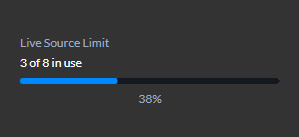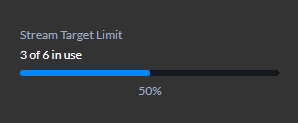Live sources and stream targets¶
Each incoming live stream or feed received by Makalu is referred to as a live source. Makalu distinguishes between the following types of live sources:
- compressed signals (for example, live sources received via SRT, which are highlighted in the Makalu UI with a red thumbnail)
- uncompressed signals (for example, SDI live sources in on-premise environments, which are highlighted in the Makalu UI with a green thumbnail)
Live sources are used by multiple Makalu apps, for example, to preview incoming streams or to schedule them in a rundown. Each playout output signal can also be routed internally and used as a live source ("backchannel") again. Every live source is defined by a set of configuration properties (metadata), such as the used protocol, the URL used to receive the stream, or (if required) stream credentials. These configuration properties can, for example, be used to set up an external device or software that provides an incoming source stream to Makalu.
The target for each outgoing live stream is referred to as a stream target. Like a live source, each stream target is defined by a set of configuration properties (metadata), such as the used protocol, the target URL, or (if required) stream credentials. Stream targets can be used by multiple Makalu apps, for example, to schedule them in a rundown, defining which parts of the scheduled program should be streamed to downstream service providers or video platforms.
To manage, preview, monitor, and route incoming and outgoing live streams, Makalu includes the Stream Control app.
Accessing Makalu Stream Control¶
To access Makalu Stream Control, proceed as follows:
-
Open the Makalu Hub as described in section Accessing the Makalu Hub.
-
In the app list in the left column, in the section Streams, select Makalu Streams.
The Stream Control UI is opened in the Streams tab of the main Makalu UI.
Manage live sources¶
Using the live sources overview¶
To access the live sources overview, in the navigation sidebar on the left, select Live Sources > Overview.
The live sources overview is displayed.
In the Live Sources area, all currently available live sources are listed with their basic properties. You can customize the columns to be displayed and manually trigger a list update by using the corresponding buttons above the list.
To display only specific live sources, use the Filter area above the list. There, you can search live sources by name, transmission protocol, connection status, and type (backchannel or "regular" live source).
The number of available live sources is limited. Depending on the infrastructure and the Makalu subscription, this number may vary. The total number of live sources available and current utilization is displayed at the bottom left under Live Source Limit:
Creating a live source¶
To create a live source, proceed as follows:
-
In the navigation sidebar on the left, select Live Sources > Overview.
-
In the upper right, click Create.
The Create a live source menu is displayed.
-
Enter a unique name for the live source and select the protocol to be used.
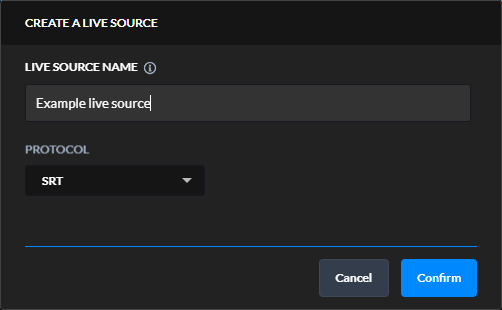
Stream Control - Create live source Notice
Depending on the selected protocol, additional configuration properties may be displayed. Enable or select them as necessary.
For example, if you select the RTMP protocol, you can enable authentication via the additional property On Connect Authenticate. If enabled, the URL of the created live source (which must be used to provide the source stream to Makalu) will include a username and password for authentication.
When you select the SRT protocol, you can enable AES encryption via the additional property Use SRT PassPhrase. If you enable it, you can additionally select the type of AES encryption to be used (128, 192, or 256 bits).
-
(Optional) To make the live source available only to selected channels, select one or more channels in the Send to multiple channels dropdown menu.
-
Click Confirm.
The live source is created with the selected properties and added to the list of available live sources. It is also available in Makalu Traffic as a primary event and can be added to shows. In Makalu Automation, it is available under Media > Live and can be previewed and added to the rundown.
Notice
You can now configure your upstream device/software/encoder that provides the actual source stream to Makalu by using the configuration properties of the live source you created. To do this, select the newly created live source, copy the values of the corresponding configuration properties to the clipboard, and paste them into your device/software settings. Afterward, start the stream. If everything is configured properly and the incoming stream is received correctly by Makalu, the live source status changes from red (disconnected) to green (connected), and the preview can be started.
Previewing a live source¶
To preview a live source, proceed as follows:
-
In the navigation sidebar on the left, select Live Sources > Overview.
-
In the live sources list, click the name of the live source to be previewed.
A preview player and detailed information about the live source are displayed at the top of the page.
-
In the preview player, click the Play icon.
The preview starts.

Stream Control - Live source preview -
Use the player controls, for example, to trigger pause, play, or full-screen view.
Editing a live source¶
Notice
You can only edit the name and assigned channels of a live source. All other settings cannot be changed as they are automatically generated.
To edit a live source, proceed as follows:
-
In the navigation sidebar on the left, select Live Sources > Overview.
-
In the live sources list, click the name of the live source to be edited.
A preview player and detailed information about the live source are displayed at the top of the page.
-
Edit the properties as required (Name and/or assigned Channels).
-
Click Save.
The changed live source configuration is saved.
Deleting a live source¶
Notice
You can only delete "regular" live sources. Backchannel live sources cannot be deleted.
To delete a live source, proceed as follows:
-
In the navigation sidebar on the left, select Live Sources > Overview.
-
In the live sources list in the Action column, activate the checkbox of the live source to be deleted.
-
Click the Delete selected live source icon above the live sources list.
-
Confirm the displayed dialog by clicking Confirm.
The live source is deleted and removed from the list.
Manage stream targets¶
Using the stream targets overview¶
To access the stream target overview, in the navigation sidebar on the left, select Stream Targets > Overview.
The stream target overview is displayed.
In the Stream Targets area, all currently available stream targets and jobs are listed, along with basic information (such as name, type, source, and status). You can customize the columns to be displayed and manually trigger a list update by using the corresponding buttons above the list.
To display only specific stream targets, use the Filter area above the list. There, for example, you can search stream targets by name, type (YouTube, Generic, etc.), or active status.
You can display and edit the details of each stream target by clicking the corresponding stream target name.
The number of available stream targets is limited. Depending on the infrastructure and the Makalu subscription, this number may vary. The total number of stream targets available and current utilization is displayed under Stream Targets > Static Routing at the bottom left under Stream Target Limit:
Creating a static routing stream target¶
A static routing stream target enables you to permanently stream any live source to any valid target, without having to schedule it in a rundown.
To create a static routing stream target, proceed as follows:
-
In the navigation sidebar on the left, select Stream Targets > Static Routing.
-
In the upper right, click Add.
The Create a stream target menu is displayed.*
-
Select the protocol to be used.
Depending on the selected protocol, different configuration properties are displayed.
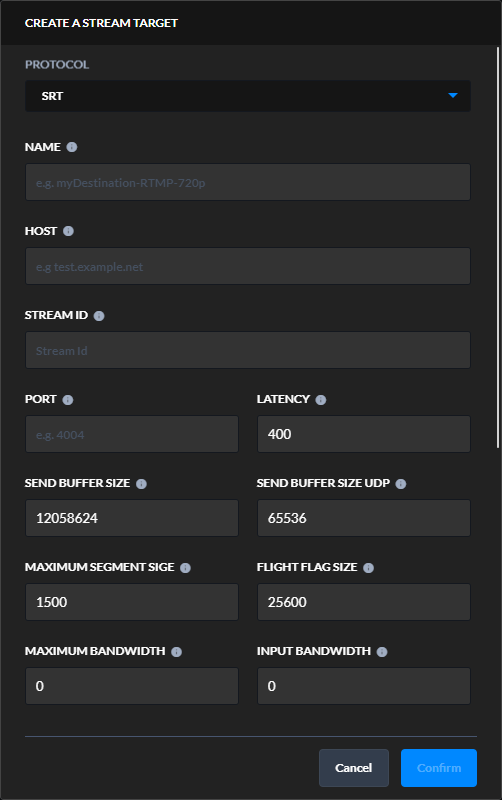
Stream Control - Static routing stream target properties -
Set all configuration properties as required.
-
Click Confirm.
The static routing stream target is created and added to the stream targets list with the status inactive (red).
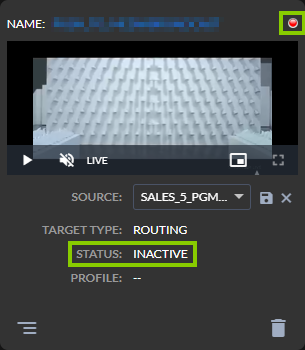
Stream Control - Static routing stream target created -
Select the live source to be used via the Source dropdown menu.
If the source stream is valid and running, preview playback starts automatically.
-
Right next to Source, click the Save source stream icon.
The source of the static routing stream target is saved. If the source and target are valid and the stream is running, the status changes to active (green).
Notice
To preview the live source, in the preview player, click the Play icon and use the player controls, for example, to trigger a full-screen preview.
Editing a static routing stream target¶
To edit a static routing stream target, proceed as follows:
-
In the navigation sidebar on the left, select Stream Targets > Static Routing.
-
Look for the target to be edited and, in the bottom left of the corresponding tile, click the View and edit configuration data icon.
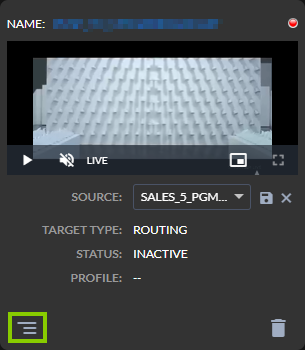
Stream Control - Open static routing stream target settings The target settings are displayed.
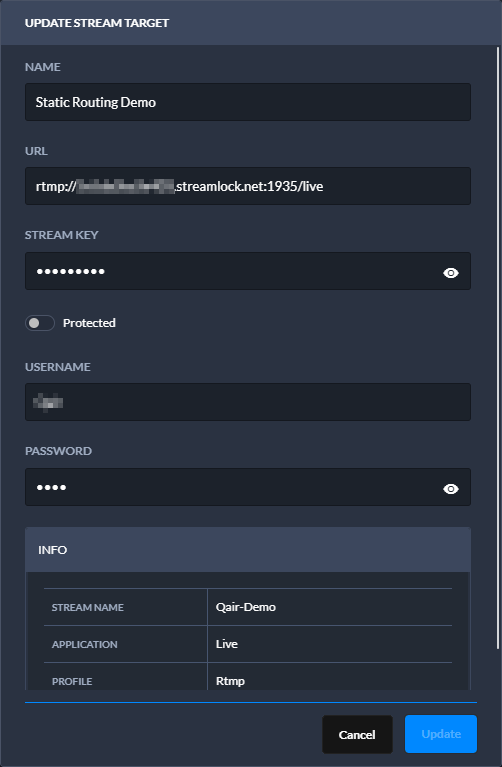
Stream Control - Static routing stream target settings -
Change the settings as required.
-
Confirm your changes by clicking Update.
The changed static routing stream target settings are saved.
Deleting a stream target¶
To delete a stream target, proceed as follows:
-
In the navigation sidebar on the left, select Stream Targets > Overview.
-
In the stream targets list in the Action column, activate the checkbox of the stream target to be deleted.
-
Click the Delete selected stream target icon above the live sources list.
-
Confirm the displayed dialog by clicking Confirm.
The stream target is deleted and removed from the list of stream targets.
Synchronizing stream targets between Wowza and Makalu¶
Under certain conditions (for example, due to special customer requirements regarding the stream format or certain specific stream properties), it may not be possible to create a stream target using the default mechanism provided by Makalu Stream Control. In this case, the corresponding stream target must be created manually via the Wowza Manager UI. Afterward, it can be synchronized with Makalu via Stream Control and can then be used like a "regular" stream target.
To synchronize stream targets, proceed as follows:
-
In the navigation sidebar on the left, select Stream Targets > Static Routing.
-
In the upper right, click Sync.
All stream targets created via the Wowza Manager UI and that can be synchronized are listed.
-
Select one or more stream targets to be synchronized.
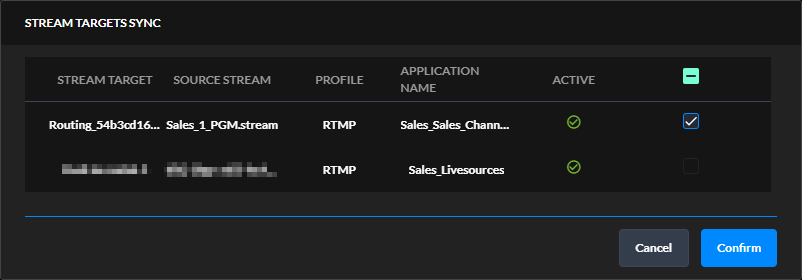
Stream Control - Synchronize stream targets -
Click Confirm.
The selected stream targets are synchronized with Makalu and can afterward be used like "regular" stream targets.
